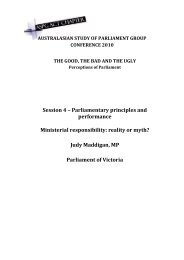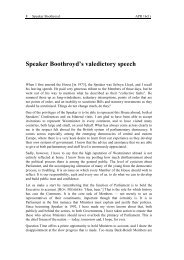Comic Commentators: Contemporary Political Cartooning in Australia
Comic Commentators: Contemporary Political Cartooning in Australia
Comic Commentators: Contemporary Political Cartooning in Australia
- No tags were found...
Create successful ePaper yourself
Turn your PDF publications into a flip-book with our unique Google optimized e-Paper software.
Spr<strong>in</strong>g 2009 Book pages 239cartoonists have had over their jokes until quite recently’. 36 That is, as art more thanhumour.For cartoons, though, visual appeal may be the least of it. There is a surpris<strong>in</strong>g lackof comment <strong>in</strong> the contributions to this volume about cartoonists’ very differentstyles which may appeal <strong>in</strong> different measure. Only Phiddian <strong>in</strong> his chapterdedicated to Petty, and Thomas <strong>in</strong> his on both Petty and Cook, make a po<strong>in</strong>t of it.For Phiddian, of Petty, ‘noth<strong>in</strong>g I have seen of his work s<strong>in</strong>ce 1960 has been easy tolook at, or enterta<strong>in</strong><strong>in</strong>g <strong>in</strong> a simple sense (p. 190)…To the extent that it isoccasionally beautiful, it is a difficult beauty, <strong>in</strong> which critical <strong>in</strong>telligence is neversacrificed to whimsy’. For Thomas Petty’s diagrams are ‘a sort of no-flowchart…unique warn<strong>in</strong>gs or morality tales, show<strong>in</strong>g us just where we have gonewrong and how deeply lost <strong>in</strong> the maze we have allowed ourselves to become’(p. 237).Does style affect impact ? Does the chaos of Petty’s excruciat<strong>in</strong>g squiggles deter theviewer from work<strong>in</strong>g through to his mean<strong>in</strong>g? Does the sparse, spare, naive style ofa Horacek, a Katauskas or a Sharpe result <strong>in</strong> the viewer tak<strong>in</strong>g their message lessseriously? What is the effect of Moir’s bold metaphors pitched from the moral highground, Nicholson’s prescient serial election campaign themes, or of Pryor’smuscular, grand, dramatic, realistic portraiture? Do any of these have differentappeal, or impact? We do not know and are not told. The answers to thesequestions, <strong>in</strong> one sense, probably don’t matter for, <strong>in</strong> the context of analysis from apolitical communication po<strong>in</strong>t of view, it is the message more than the medium onwhich the editorial cartoon will s<strong>in</strong>k or swim, more than the draft<strong>in</strong>g skills of theircreators.Paradoxically perhaps <strong>in</strong> the circumstances, Hansen lauds the parad<strong>in</strong>g of cartoonsas art, that is, framed for exhibition, and put on a wall for quiet reflection when thissurely makes them more like art than anyth<strong>in</strong>g else. There will be different views onthis but I, for one, am with Steve Bell 37 when he says that that their impact comesfrom their appearance <strong>in</strong> a sea of associated text. Too often otherwise, cut off fromthe lifeblood which gives them birth, the nuance of the context is lost, or too muchscript needs to be attached <strong>in</strong> explanation for it to grab the attention of the viewer asit does with the cornflakes and coffee and the day’s unfold<strong>in</strong>g news.36 Her <strong>in</strong>troduction, p. 5.and p. 42 — <strong>in</strong>terference with captions was common until quiterecently.37 Steve Bell, ‘Steve Bell <strong>in</strong> America’, Cartoon History…
















